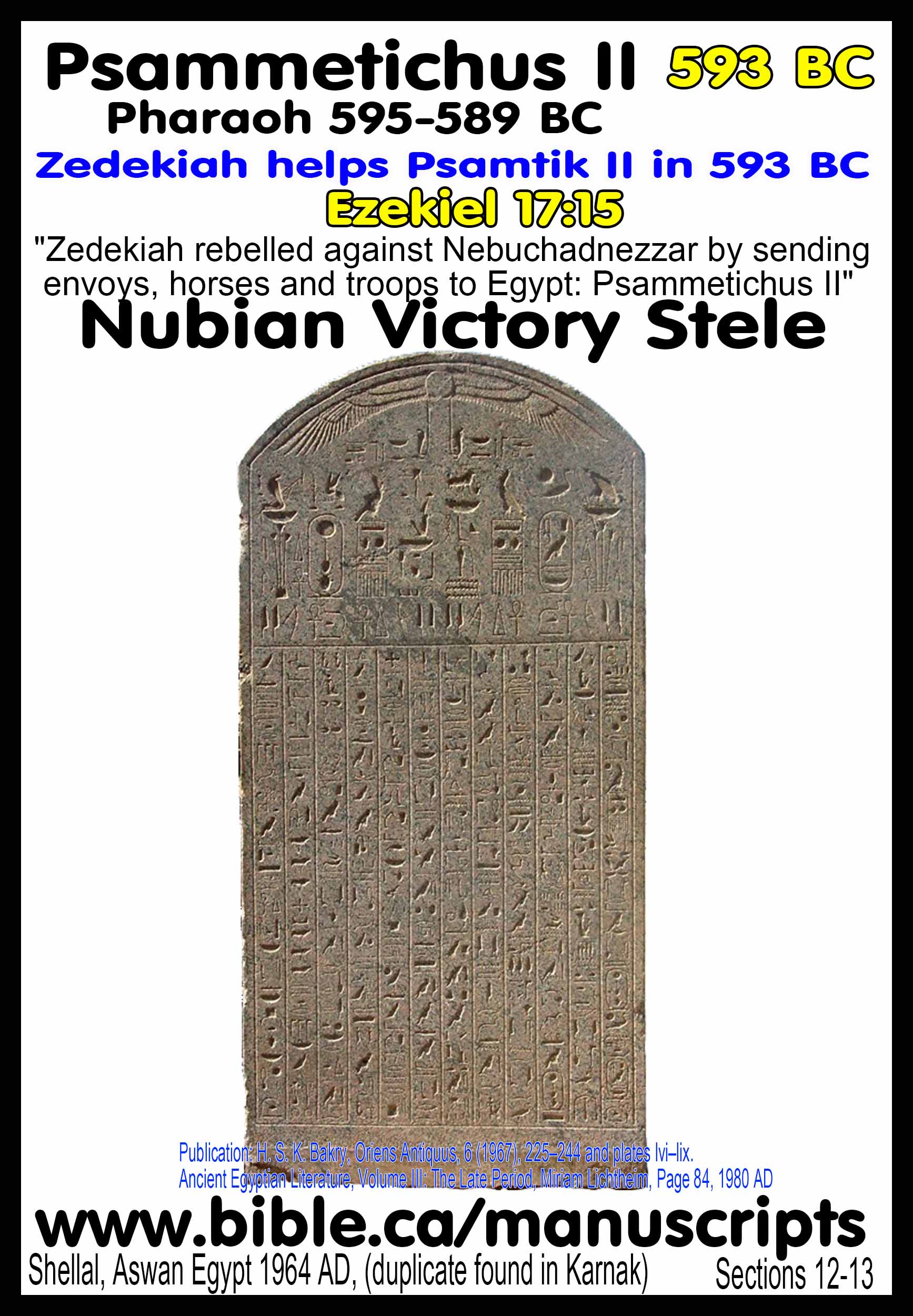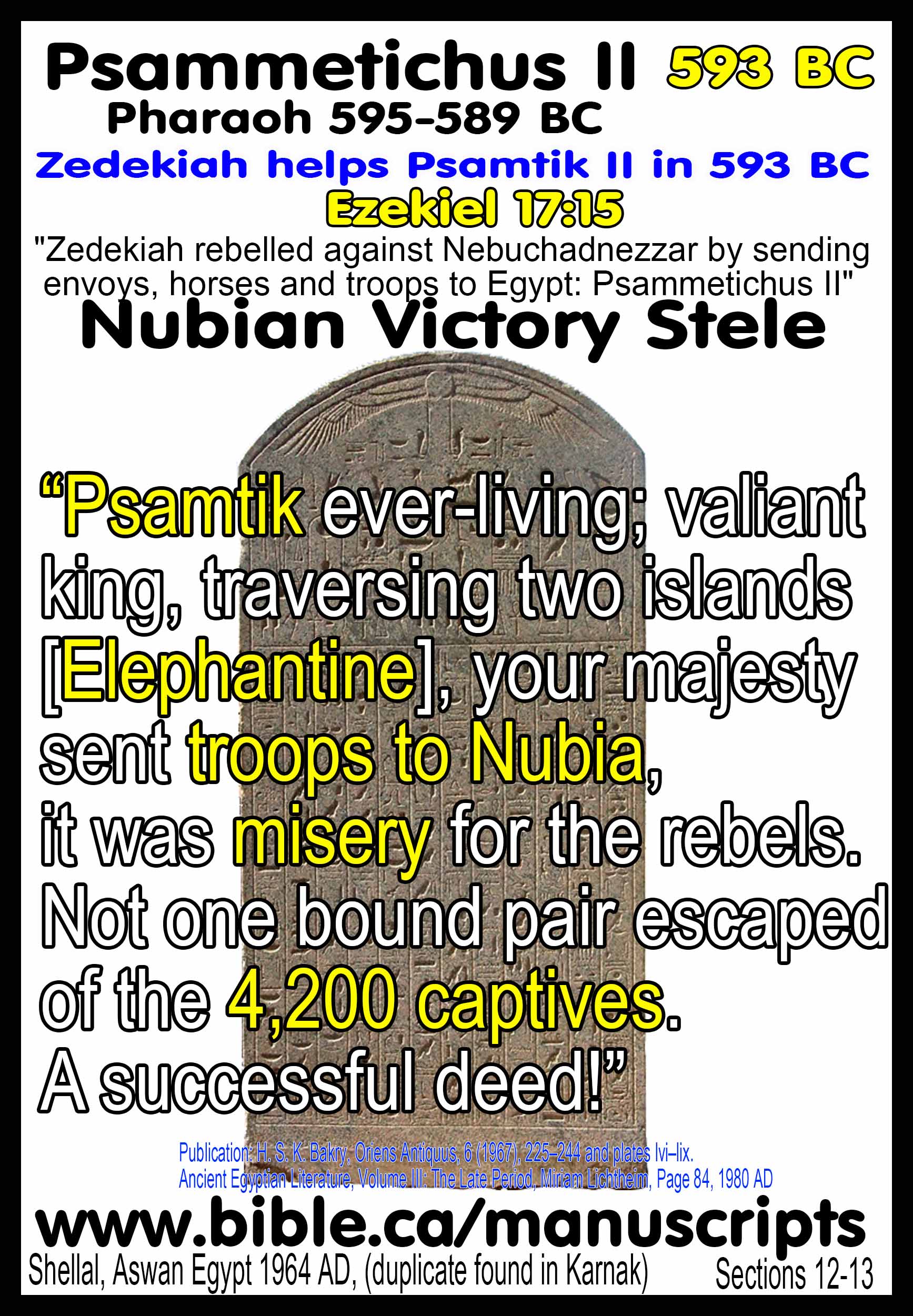593 BC Stele of Pharaoh Psammetichus II (Psamtik II) 595-589 BC
Zedekiah helps the King of Egypt in the military campaign of into Nubia of 593 BC
|
Translation Psamtik II Stele "Psamtik ever-living; valiant king, traversing two islands [Elephantine], your majesty sent troops to Nubia, it was misery for the rebels. Not one bound pair escaped of the 4,200 captives. A successful deed!” (Steve Rudd Adapted from Lichtheim) |
|
Digging up Bible stories!
This stele dates to 593 BC documents the Nubian campaign of Psamtik II and directly supports where Ezekiel 17:15 says King Zedekiah sent troops, horses and envoys to help Pharaoh Psammetichus II in 593 BC.
Zedekiah, King of Judah: Detailed outline. |
|
What you read in the book you find in the ground! |
Introduction:
- Pharaoh Psammetichus II (Psamtik II) 595-589BC has five important events:
a. 593 BC: Psammetichus II's successful campaign in Nubia (victory inscription)
b. 595 BC: Fortifying the Jewish colony at Elephantine established by Manasseh.
c. 592 BC: Psammetichus II's visit to (Khor) Judea and Philistia (Demotic Papyri)
d. 592 BC: Psammetichus II as one of the two eagles of Ezekiel 17
e. 589 BC: Psammetichus II's support of Zedekiah's rebellion to Nebuchadnezzar
- Dig reports and publications:
- H. S. K. Bakry, Oriens Antiquus, 6 (1967), 225–244 and plates lvi–lix.
- Studies of the historical background: J. Yoyotte, RdÉ, 8 (1951), 215–239. S. Sauneron and J. Yoyotte, BIFAO, 50 (1952), 157–207 and four plates
- See Zedekiah, King of Judah: Detailed outline.
I. Translation of 593 BC Stele of Pharaoh Psammetichus II (Psamtik II) 595-589 BC:
|
"(1) Year 3, 2d month of summer, day 10 under the majesty of Horus: Menekhib; King of Upper and Lower Egypt, Two Ladies: Mighty-of-arm; Gold-Horus who graces the Two Lands: Neferibre; (2) Son of Re, of his body: Psamtik ever-living; beloved of Khnum, lord of the cataract region, of Satis, lady of Yebu, of Anukis, presiding over Nubia. Good god, effective of counsel;" (continued below) |
"(3) valiant king, successful in deeds; strong-of-arm who smites the Nine Bows. His majesty was roaming the marshes at lake Neferibre, circling its inundated land, traversing its two islands [Elephantine], viewing the sycamores of god’s land on its mud bank, his heart eager (5) to see the goodness ( or, beauty ), like the Great God traversing the primeval water. Then one came to tell his majesty: “The troops your majesty sent to Nubia have reached the hill-country of Pnubs. It is a land lacking a battlefield, a place lacking horses. (7) The Nubians of every hill-country rose up against him, their hearts full of rage against him. His attack took place, and it was misery for the rebels. His majesty has done a fighter’s work. When the battle was joined the rebels turned their backs. The arrows did not stray from piercing them. (9) The hand did not let loose. One waded in their blood as in water. Not one bound pair escaped of the 4,200 captives. A successful deed has been done!” Then the heart of his majesty was happy beyond anything. His majesty presented (11) a great sacrifice of oxen and shorthorns to all the gods of Upper and Lower Egypt, and an offering to the gods of the palace in the palace chapel. May he be given all life, stability, dominion, all health and happiness like Re forever!" " (Ancient Egyptian Literature, Volume III: The Late Period, Miriam Lichtheim, Page 84, 1980 AD)
II. Authorities on 593 BC Stele of Pharaoh Psammetichus II (Psamtik II) 595-589 BC:
1. "Found at the village of Shellal, near Aswan, in 1964, this stela turned out to be the duplicate of a previously known stela of Psamtik II found at Karnak. Whereas the Karnak stela is a fragment, the Shellal stela is complete. It is a round-topped stela of red granite, 2.53 m high. In the lunette, under the winged sun-disk, are the cartouches of the king. Below is the inscription in twelve columns." (Ancient Egyptian Literature, Volume III: The Late Period, Miriam Lichtheim, Page 84, 1980 AD)
2. "It is an important monument, for it sheds further light on Psamtik II’s Nubian campaign, a campaign already known from other sources, notably from Herodotus II, 161, from a fragmentary stela found at Tanis in 1937, from the Karnak stela fragment mentioned above, and from the graffiti which the king’s foreign mercenary troops inscribed on two of the colossi of Ramses II at Abu Simbel. " (Ancient Egyptian Literature, Volume III: The Late Period, Miriam Lichtheim, Page 84, 1980 AD)
3. "The historical situation has been elucidated by J. Yoyotte and S. Sauneron in two articles (see below). In the earlier article Yoyotte pointed out that the numerous erasures of royal names of the Nubian Twenty-fifth Dynasty on their monuments in Egypt must have been the work of Psamtik II. These erasures and the campaign are evidence of renewed hostility between Egypt and the Nubian kingdom. " (Ancient Egyptian Literature, Volume III: The Late Period, Miriam Lichtheim, Page 84, 1980 AD)
5. "In addition to its historical interest, the text has some noteworthy literary features, notably the description of the king’s sightseeing tour in the region of Elephantine with its evocation of a pleasant landscape of water and trees. The king had not himself led the army into Nubia, but had remained in this peaceful setting, and it was here that he received the report of the successful battle, a report which contains the remarkable expression “wading in blood as in water.” " (Ancient Egyptian Literature, Volume III: The Late Period, Miriam Lichtheim, Page 84, 1980 AD)
Conclusion:
- What we read in the book, we find in the ground, or in this case in the Stele of Pharaoh Psammetichus II (Psamtik II) which dates to 593 BC.
By Steve Rudd: Contact the author for comments, input or corrections.



